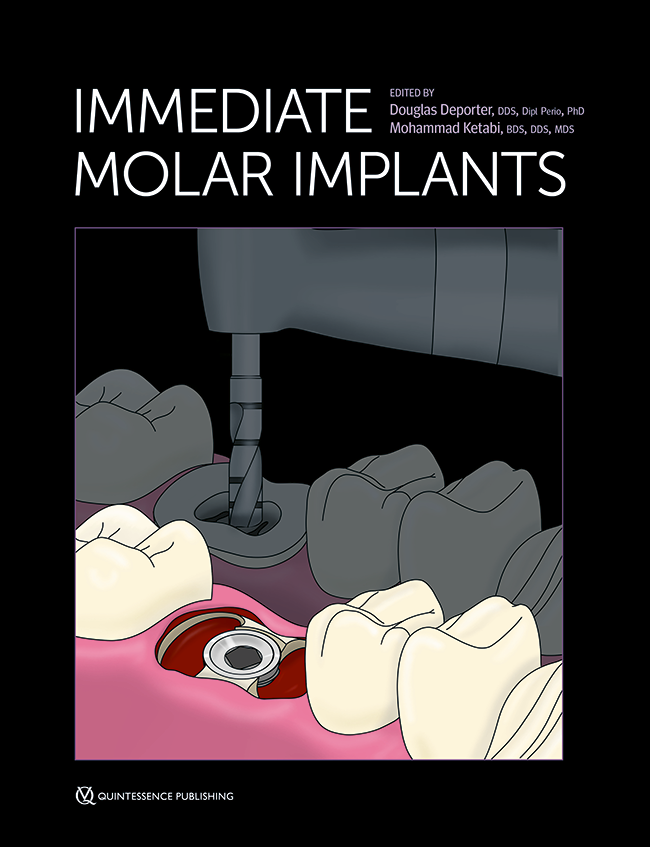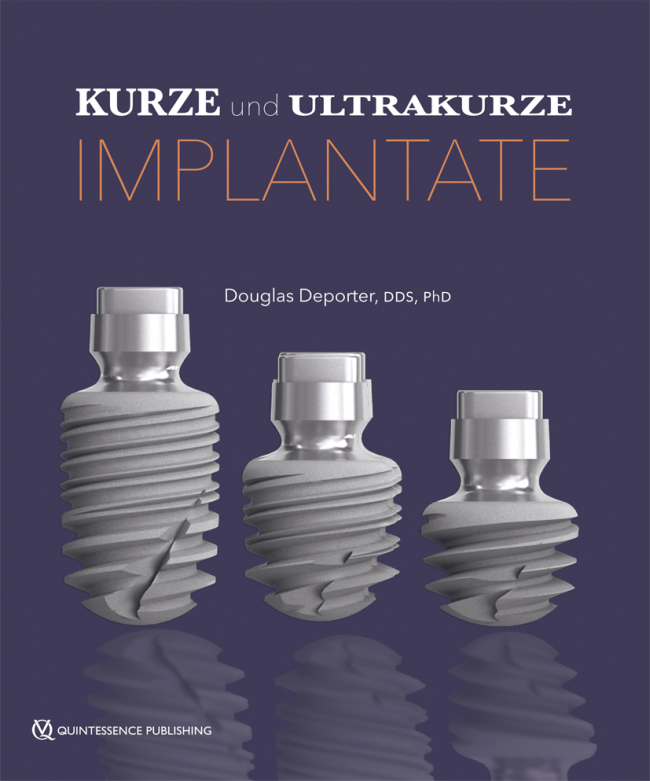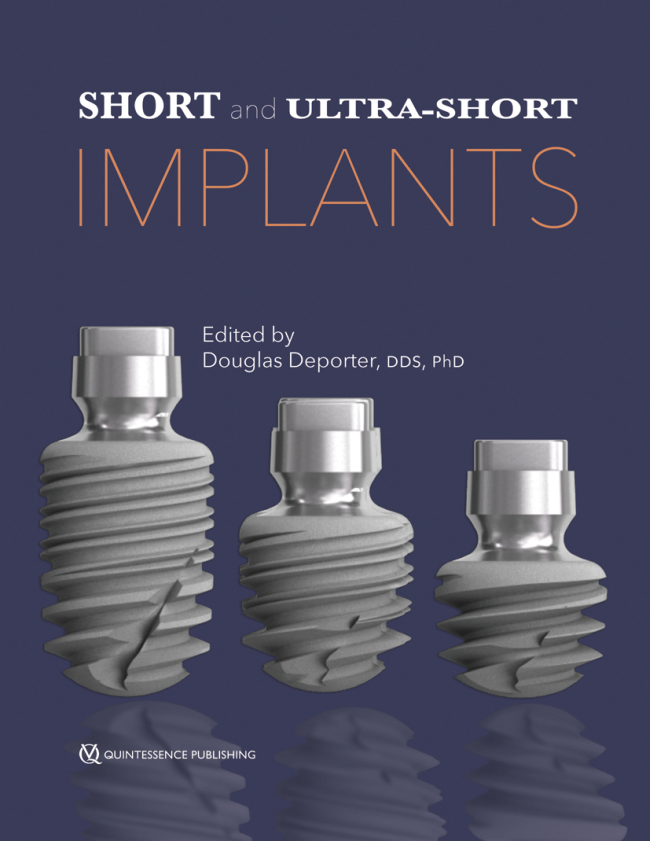International Journal of Periodontics & Restorative Dentistry, 2/2014
DOI: 10.11607/prd.1542, PubMed-ID: 24600658Seiten: 225-231, Sprache: EnglischKermalli, Jaffer Y. / Deporter, Douglas A. / Atenafu, Eshetu G. / Lam, Ernest W.Three implant designs were used to treat posterior partial edentulism. A total of 799 implants (563 Osseotite, 65 Straumann SLA,171 Endopore SPS) were placed in 345 patients. SPS implants were used in sites with less bone, had shorter lengths, and functioned longer than the threaded implant designs. Comparing implant losses, SPS implants had a higher failure rate (9.3%) compared with Osseotite (4.0%) or SLA (0%) implants. SPS implant losses generally occurred as late failures, while Osseotite losses were early failures. However, among surviving implants, SPS implants had less crestal bone loss at all time intervals compared with both of the threaded implant designs. (Int J Periodontics Restorative Dent 2014;34:225-231. doi: 10.11607/prd.1542)
International Journal of Periodontics & Restorative Dentistry, 6/2013
Online OnlyDOI: 10.11607/prd.1629, PubMed-ID: 24116369Seiten: 145-152, Sprache: EnglischKetabi, Mohammad / Deporter, DouglasThis paper summarizes current knowledge on the benefits of laserablated microgrooves in neck regions of endosseous dental implants. Like machine-tooled coronal microthreads with particle-blasted surfaces, laser-ablated microgrooves help to preserve crestal bone. However, they also appear to uniquely favor a true gingival connective tissue attachment comparable to that of natural teeth.
International Journal of Periodontics & Restorative Dentistry, 4/2013
DOI: 10.11607/prd.1304, PubMed-ID: 23820705Seiten: 457-464, Sprache: EnglischDeporter, DouglasDental implants with lengths = 8 mm have been used with success in posterior arch regions where significant alveolar ridge resorption has occurred. Nevertheless, many clinicians are reluctant to use them regularly, if at all. Key factors for success include implant surface roughness, surgical placement methods, and, possibly, implant diameter, all of which are discussed here.
International Journal of Periodontics & Restorative Dentistry, 5/2012
PubMed-ID: 22754904Seiten: 563-570, Sprache: EnglischDeporter, Douglas A. / Kermalli, Jaffer / Todescan, Reynaldo / Atenafu, EshetuThis article updates the results of a prospective clinical trial of press-fit, sintered, porous-surfaced dental implants placed in the posterior mandible of partially edentulous patients. Implants used had overall lengths (including transgingival collar regions) of 7 or 9 mm with designed intrabony lengths (lengths of sintered surface in contact with bone) of 6 or 8 mm. Forty-eight implants were placed in 24 patients, the majority of which replaced molar teeth, and the mean crown-toroot ratio was 1.4. Over 10 years of implant function, 2 patients with 3 implants died and 3 patients with 4 implants were lost to follow-up because of infirmity or relocation. The survival and success rates were both 95.5%. Two implants failed; the mean cumulative crestal bone loss (measured from the implantabutment interface) for the remaining implants was 1.2 mm. Crestal bone loss was not affected by the crown-to-root ratio, prosthesis design, or whether an implant was the most distal unit in a sextant. However, there was a trend for greater crestal bone loss when implants were opposed by implants rather than by natural teeth.
International Journal of Periodontics & Restorative Dentistry, 6/2009
PubMed-ID: 20072740Seiten: 625-633, Sprache: EnglischDeporter, DouglasWhereas the majority of endosseous dental implants have threaded screw geometries, press-fit implants with a sintered porous surface (SPS) geometry integrate via three-dimensional bone ingrowth. These two classes of implants are suited for different site conditions and, when used appropriately, will provide optimal and minimally invasive treatment protocols. The present report argues that generally, threaded screw implants perform best in long lengths (with a "defined intrabony length" above 8 mm) and denser bone, while press-fit SPS implants perform optimally at short lengths ("defined intrabony length" of 5 mm or less) and in primarily cancellous bone. Threaded implants are more appropriate for immediate placement and immediate loading, while press-fit SPS implants perform well in resorbed posterior sites, including maxillary sites with as little as 3 mm of subantral bone. Understanding the benefits and limitations of these two implant concepts is key to successful and minimally invasive implant treatment.
International Journal of Periodontics & Restorative Dentistry, 2/2009
PubMed-ID: 19408481Seiten: 191-199, Sprache: EnglischMacDonald, Kevin / Pharoah, Michael / Todescan, Reynaldo / Deporter, DouglasThis report from a prospective study discusses the status of a group of 20 single maxillary sintered porous-surfaced (SPS) dental implants after 7 to 9 years in function restored with screw-retained crowns. Twenty patients each received a single SPS implant placed in a two-stage surgical approach; 65% replaced premolar or molar teeth, while the remainder replaced anterior teeth. Patients were examined annually. Standardized radiographs were used to assess peri-implant crestal bone levels and to determine an implant success rate. Jemt Papilla Index scores were used to assess the extent of papilla reformation between each implant and its two contiguous teeth. After 7 to 9 years, 17 implants were available for assessment (one patient had died, and two patients had moved away). One implant was removed after the 9-year visit because of progressive bone loss, giving a survival rate of 92.9%. The failure of this implant was related to deficiency in initial alveolar ridge width with loss of the remaining thin buccal cortical plate. With the exception of the failed implant, no significant changes in mean annual crestal bone loss were noted from years 1 to 9, giving a similar success rate (92.9%). Jemt Papilla Index scores of 2 or 3 were assigned for the majority of papillae. SPS implants can be used effectively to replace single missing maxillary teeth.
The International Journal of Oral & Maxillofacial Implants, 3/2008
PubMed-ID: 18700381Seiten: 544-550, Sprache: EnglischDeporter, Douglas A. / Al-Sayyed, Arwa / Pilliar, Robert M. / Valiquette, NancyPurpose: The aim of this study was to obtain histometric measurements of bone and peri-implant mucosal tissue contact with implants of 2 sintered porous-surfaced designs. The "short-collar" design had a collar height (smooth coronal region) of 0.75 mm, while the "long-collar" model had a smooth coronal region of 1.8 mm.
Materials and Methods: Implants (2 per side) were placed in healed mandibular extraction sites of 4 beagle dogs using a submerged technique. After 4 weeks of healing, they were uncovered and used to support fixed partial dentures for a 9-month period. After sacrifice, specimens were retrieved and nondemineralized sections were examined histometrically to determine the most coronal bone-to-implant contact (first BIC) using the microgap as a reference and standard mucosal parameters of "biologic width".
Results: Significant (P = .001) differences in first BIC were found between designs (1.97 mm for long-collar versus 1.16 mm for short-collar implants) for posteriorly located implants but not for anteriorly located ones (1.21 mm versus 1.38 mm; P = .40). If crestal bone loss involved sintered surface, fibrous connective tissue ingrowth was observed to replace lost bone. No significant differences in peri-implant mucosal measurements (total peri-implant mucosal thickness; length of the epithelial component of this mucosa, and thickness of the connective tissue component) were detected between implant designs.
Conclusions: Results suggest that "biologic width" accommodation drives initial crestal bone loss with sintered porous-surfaced implants. Histometric data obtained for bone contact showed no significant differences between the long- and short-collar implant designs.
Schlagwörter: biologic width, bone remodeling, collar height, sintered porous-surfaced dental implants
The International Journal of Oral & Maxillofacial Implants, 6/2007
PubMed-ID: 18271376Seiten: 948-954, Sprache: EnglischShimada, Eiji / Pilliar, Robert M. / Deporter, Douglas A. / Schroering, Robert / Atenafu, EshetuPurpose: The purpose of this study was to compare patterns of crestal bone remodeling with 2 sintered porous-surfaced dental implant designs during a 14-month functional period.
Materials and Methods: Two root-form press-fit dental implants were evaluated in healed extraction sites in dog mandibles. The standard (control) design was a press-fit implant with a 2-mm machined collar; the remainder of the implant had a sintered porous surface. The test or "hybrid" design had 3 coronal machined threads instead of a machined collar; the remainder of the implant had a sintered porous surface.
Results: Standardized radiographs indicated significantly less crestal bone loss (0.82 to 0.93 mm versus 1.45 to 1.5 mm) with the hybrid design and a slower approach toward an apparent steady state (12 to 14 months for the hybrid versus 7 months for the standard design). Morphometric assessment of back-scattered scanning electron micrographs confirmed that crestal bone loss was significantly less for the hybrid design on all but the lingual implant aspect.
Conclusion: The addition of coronal threads to an implant relying on a sintered porous surface geometry for its long-term osseointegration reduced the extent of crestal bone loss compared to a machined collar region.
Schlagwörter: coronal threaded collar, crestal bone loss, implant design, machined smooth collar
The International Journal of Oral & Maxillofacial Implants, 6/2006
PubMed-ID: 17190297Seiten: 879-889, Sprache: EnglischPilliar, Robert M. / Sagals, Genadijs / Meguid, Shaker A. / Oyonarte, Rodrigo / Deporter, Douglas A.Purpose: A 3-dimensional finite element model was developed to investigate the cause of different crestal bone loss patterns observed around sintered porous-surfaced and machined (turned) threaded dental implants used for orthodontic anchorage in a previously reported animal study.
Materials and Methods: Twenty-noded structural solid elements with parabolic interpolation between nodes were used for modeling the bone-implant interface zone. A 3-N traction force acting between either 2 porous-surfaced or 2 machined threaded implants placed in canine premolar mandibular sites and bone profiles observed at initiation and 22 weeks of orthodontic loading were modeled.
Results: Higher maximum stresses in peri-implant bone next to the coronal region of the implants were predicted with the machined threaded implants at both the initial and final time points, with the values 20% greater than those predicted after the 22-week loading period. These values were approximately 200% greater than those predicted for the porous-surfaced implants, for which a more uniform stress distribution was predicted.
Discussion: The finite element model results indicated that the observed greater retention of crestal bone next to the porous-surfaced implants was attributable to lower peak stresses developing in crestal peri-implant bone with this design, which decreased the probability of bone loss related to local overstressing and bone microfracture.
Conclusion: The predicted lower stresses were a result of the more uniform transfer of force from implant to bone with the porous-surfaced implants, which was a consequence of the interlocking of bone and implant possible with this design.
Schlagwörter: alveolar process, dental esthetics, dental implants, facial growth, jawbone, orthodontics, puberty
International Journal of Periodontics & Restorative Dentistry, 6/2005
Seiten: 585-593, Sprache: EnglischDeporter, Douglas A./Caudry, Suzanne/Kermalli, Jaffer/Adegbembo, AlbertThe object of this report was to provide further data supporting the use of short (primarily 7-mm-long) dental implants with a sintered, porous-surface geometry to treat the posterior maxilla using the indirect, osteotome-mediated, localized sinus elevation procedure. Records were available for 104 Endopore implants (Innova) in 70 patients, for whom the majority of implants had been placed in the location of the maxillary first molar. The mean initial subantral bone height before implant placement was 4.2 mm, with a range of 2 to 6.7 mm, and all implants were placed using hand osteotomes and a graft of bovine hydroxyapatite. After an average time in function of 3.14 years, only two implants had been lost, both as a result of unusual circumstances. It is concluded that the use of short, sintered, porous-surfaced implants and localized indirect sinus elevation is a predictable and minimally invasive approach to manage the posterior maxilla with minimal preoperative subantral bone height.







